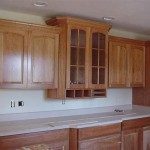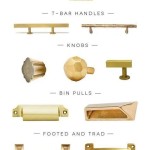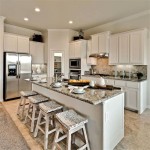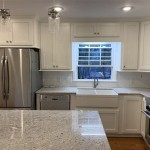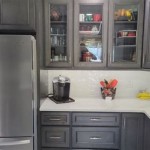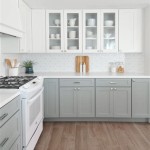What Color Flooring Goes With White Kitchen Cabinets?
Selecting the appropriate flooring to complement white kitchen cabinets is a critical element in achieving a cohesive and aesthetically pleasing kitchen design. White cabinets offer a versatile canvas, allowing for a broad range of flooring options. However, thoughtful consideration of color, material, and style is paramount to ensure the chosen flooring enhances the overall design and meets the functional demands of a kitchen environment.
The decision-making process should involve evaluating the existing architectural style of the home, the amount of natural light the kitchen receives, and the desired ambiance. Darker floors will ground the space and create a sense of formality, while lighter floors can enhance brightness and create an airy, open feel. Furthermore, understanding the maintenance requirements of different flooring materials is crucial for long-term satisfaction.
Beyond aesthetics, practicality is a significant factor. Kitchens are high-traffic areas prone to spills and messes. Therefore, durability, water resistance, and ease of cleaning are essential considerations. Materials like tile, hardwood, laminate, and vinyl offer varying degrees of performance in these areas, influencing the final decision.
Creating Contrast with Dark Hardwood Floors
Dark hardwood floors present a striking contrast against white kitchen cabinets, creating a sophisticated and elegant look. The richness of dark wood, such as walnut, mahogany, or stained oak, adds depth and warmth to the kitchen, preventing it from feeling sterile or overly clinical. This contrast highlights the crispness of the white cabinets and creates a visually appealing focal point.
The inherent grain patterns in hardwood add texture and visual interest to the floor, preventing it from appearing flat. This natural variation complements the clean lines of white cabinetry. To further enhance the contrast, consider using a lighter grout color with any tiled backsplash or accent areas.
However, it is important to be aware that dark hardwood floors require more maintenance than lighter options. They tend to show dust, scratches, and footprints more readily. Regular sweeping and occasional refinishing may be necessary to maintain their appearance. Additionally, in kitchens with limited natural light, dark floors may contribute to a darker overall ambiance, which can be mitigated with ample artificial lighting.
Consider the specific shade of white used for the cabinets when selecting the hardwood stain. Warmer whites may pair better with warmer-toned dark woods, while cooler whites may benefit from cooler-toned dark woods. Samples of both the cabinet paint and the hardwood stain should be compared in the kitchen’s lighting conditions to ensure a harmonious pairing.
From a practical standpoint, ensure the hardwood flooring is properly sealed and treated for use in a kitchen environment. Moisture resistance is key to preventing damage from spills and humidity. Engineered hardwood, which consists of layers of wood with a hardwood veneer, can offer improved stability and moisture resistance compared to solid hardwood.
Achieving Brightness with Light-Colored Tile Floors
Light-colored tile floors, such as white, cream, or light gray, offer a bright and airy aesthetic that complements white cabinets beautifully. These floors reflect light, making the kitchen feel more spacious and open. They are particularly well-suited for smaller kitchens or those with limited natural light.
Porcelain tile is a popular choice for kitchens due to its durability, water resistance, and ease of maintenance. Ceramic tile is another option, but it may be less durable than porcelain. Both types of tile are available in a wide range of sizes, shapes, and finishes, allowing for creative designs and patterns.
To prevent a completely monochromatic look, consider incorporating subtle variations in color or texture within the tile. For example, a light gray tile with a slight marble effect can add visual interest without overwhelming the space. Alternatively, using a patterned tile in a small area, such as under the kitchen island, can create a focal point.
Grout color is a crucial element in the overall design. A light grout color will blend seamlessly with the tile, creating a clean and uniform surface. A darker grout color will accentuate the individual tiles and add definition to the floor pattern. The choice depends on the desired aesthetic and the amount of maintenance one is willing to undertake, as darker grout is less prone to staining.
When selecting light-colored tile, consider the potential for staining from spills and food particles. While tile itself is highly resistant to staining, grout can be more susceptible. Sealing the grout regularly helps to protect it from stains and makes it easier to clean. Additionally, choosing a tile with a textured surface can help to hide minor imperfections and dirt.
Embracing Natural Tones with Wood-Look Laminate Floors
Wood-look laminate flooring provides the aesthetic appeal of hardwood without the associated cost and maintenance requirements. Advancements in laminate technology have resulted in highly realistic wood grain patterns and textures, making it difficult to distinguish from actual hardwood. Laminate is also a durable and water-resistant option, making it well-suited for kitchen environments.
Natural wood tones, such as oak, maple, or birch, create a warm and inviting atmosphere that complements white kitchen cabinets. These neutral tones work well with a variety of design styles, from traditional to contemporary. A lighter wood tone can enhance the brightness of the kitchen, while a medium wood tone can add warmth and character.
When choosing a wood-look laminate, pay attention to the color variation within the planks. Laminate with a moderate amount of color variation will mimic the natural variations found in real wood, adding depth and visual interest to the floor. Avoid laminates with overly uniform color, as they may appear artificial.
Consider the plank width and length when selecting laminate flooring. Wider and longer planks can create a more expansive and luxurious feel. The plank layout can also influence the overall aesthetic. A staggered layout, where the seams between planks are offset, is a common and visually appealing option.
Laminate flooring is relatively easy to install and maintain. It typically features a click-lock system that allows for quick and easy installation without the need for glue or nails. Regular sweeping and occasional mopping are sufficient to keep the floor clean. However, it is important to use a laminate-specific cleaning product to avoid damaging the surface.
From a practical perspective, ensure the laminate flooring is rated for residential use and has a sufficient wear layer to withstand the demands of a kitchen environment. A thicker wear layer will provide greater protection against scratches, dents, and fading. Look for laminate flooring that is certified by reputable organizations to ensure its quality and durability.
The choice of underlayment is also important for laminate flooring. Underlayment provides cushioning, sound insulation, and moisture protection. Choose an underlayment that is specifically designed for use with laminate flooring and that meets the moisture requirements of the kitchen environment.
In conclusion, the best flooring color for white kitchen cabinets depends on the desired aesthetic, the amount of natural light, and the level of maintenance one is willing to undertake. Each option offers a unique approach to creating a stylish and functional kitchen space.

How To Match Kitchen Floors And Cabinets Twenty Oak

What Floor Goes With White Cabinets The Carpet Guys Have Answer

White Kitchen Cabinet Design Guide Lily Ann Cabinets

Should Your Kitchen Cabinets Match Flooring

How To Coordinate Your Kitchen With White Cabinets

Which Flooring Color Goes Best With My Cabinets Flooret

What Flooring Colors Go Best With White Cabinets 50 Floor

What Colour Floors Go Best With White Kitchen Cabinets 9 Stunning Options

Revive Your Kitchen With These 10 Fresh Color Schemes Simply Kitchens

8 Kitchen Cabinet And Wood Floor Color Combinations You Ll Love
Related Posts

